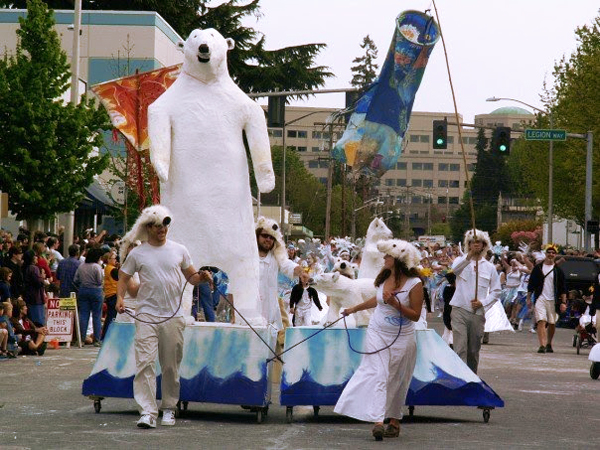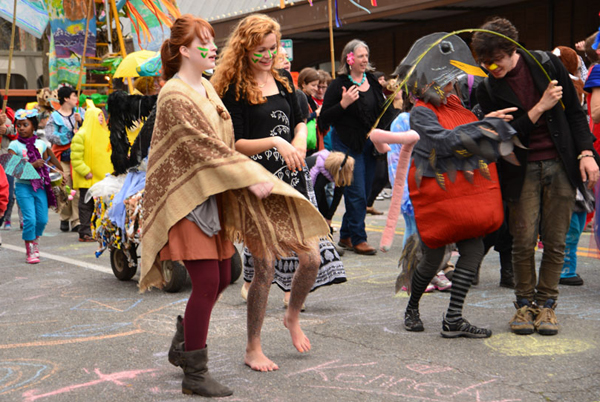Above from Creative Resistance, Procession of the Species in Olympia, WA
Procession Of The Species Honors Ecology With Art
Earthbound Productions, Olympia WA
Bruce Wilkinson: In my small community of 50,000 people the Procession of the Species stands out as being the premiere cultural and ecologically centered event of the year. Being that it draws an audience of 35,000, and participation of 4,000 every year it also stands out as being one of the strongest events nationwide that celebrates Earth Day, even though it is held the weekend afterwards plumb in the center of Earth Day to May Day.
The Procession of the Species is a joyous, spontaneous artistic pageant where community members celebrate their relationships with each other and with the natural world. Within the activist world it can be written off because one of the demands is “no words”, but the people who founded it are deep activists and present that demand as a challenge to think outside the box.
Having witnessed it’s effects for years building powerful community here, I feel strongly that it’s a serious place-making and radicalizing tool that, if taken up, will amplify all of our efforts- especially in growing the Global Climate Convergence from 2014 to 2015.
From Procession.org:
In January, 1995, a group of Olympia residents wanted to organize an event both to celebrate the 25th anniversary of Earth Day and to support Congressional renewal of the Endangered Species Act. The group decided on a positive statement of support in the form of a community celebration. They developed ideas for action and agreed on several basic tenets along with three simple rules. These became the group’s working principles. The Procession of the Species Celebration was born!
What are the three rules?
No written words
No live pets
No motorized vehicles
The Procession seeks to bridge the arts, the environment, and our local community. As a celebration of art, it involves citizens in a creative process affirming art’s place in the forum of public expression. As a celebration of species, it awakens public sensibilities to the issues surrounding environmental awareness and protection. As a celebration of community, it enhances the exchange between local schools, local government, businesses, and civic organizations.
Designed to create a cultural exchange rather than an entertainment event, the Procession is an open invitation to participate in imagination, creation, and sharing. By fostering inclusiveness and collaboration, the Procession engages area residents regardless of age, background, or ability. Providing schools, social services, businesses, tribes, and fellowships with the same opportunity, the Procession involves a broad cross section of the community.
Procession of the Species is entirely noncommercial. It exists to dignify the human spirit, celebrate human connections with each other and the natural world, and re-root communities in sharing, music, movement, art, and the human capacity for celebration and joy. Well, all that, and much much more.

One year, when I was particularly downtrodden about global warming, I worked with a few friends to build a polar bear and two bubs on an iceburg. When we were walking it would split apart separating the mother from the bubs. However we always reunited them later, and doing that visual statement uplifted my spirits. -Bruce Wilkinson
Imagine a place where you are inspired to create your expression of awe and appreciation of the natural world…then share it with others on Procession Day.
Imagine an invitation open to all to participate in weaving wonder along with people of diverse ages, abilities, and cultural backgrounds.
Imagine an open studio where you can come on your own and make a giant puppet or float; design a costume, mask, or headdress; and batik a windsock or banner.
Imagine art and music workshops – dozens of them, at low cost – where you can learn new skills and techniques to create your creature.
Imagine the support of an amazing gathering of family, friends, artists and helpful volunteers, offering all the inspiration you can shake a rattle at.
Imagine a huge collection of recycled materials—art supplies, craft supplies, scavenged stuff – all just waiting to be transformed into a work of art and celebration.
Imagine a circle of community where dancing elephants, prancing wildebeest, pirouetting butterflies, wheeling birds, and undulating salmon rivers practice their movements for Procession Day.
Imagine a building full of music, percussion, and rhythm — the heartbeat of Procession of the Species — and the sounds and sights of instruments being made and practiced.
You just imagined the Procession community art studio!
Join us – all are welcome!
Interested in starting a new Procession of the Species Celebration in your community? Get help from the folks who founded it and practical guidance from the many people who have made Olympia’s Procession possible since 1995. Feel free to contact us no matter what your level of interest.
Procession of the species started in Olympia WA and has spread to 69 locations throughout the US and across the globe. See this page to find a POS near you.
Earth Day Proclamation by Eli Sterling
Presented to the Thurston County Commissioner’s Meeting
April 16, 2013
Good day, and thank you each, the Commissioners of Thurston County, for the honor of this Earth Day Proclamation and for the opportunity to share with you the presence of the 19th Procession of the Species Celebration.
The intention of the Procession is to elevate the dignity of the human spirit by enhancing the cultural exchange between communities and the natural world… and to advance that exchange through the languages of art, music, and dance.
Each year, as organizers, we are faced with this singular question: Does any of this color and pageantry truly make a difference on behalf of the natural world?
There are two separate answers to this question. The first is explicitly expressed by the artist and sculptor, Mary Frank. During an interview on National Public Radio headlining a national retrospective of her work, Mary Frank, now at 90 years of age, was queried as to the purpose of art.
“Art,” she responded, “has many purposes: To comfort the dead and to awaken the living, to know the migration seasons of birds and fish, and to know the human immigrations of the past and present. To be able to use experiences and transform them. To make the eyes of children widen. To feel the power of color and shape. To fill an unspoken hunger for community. To give courage, use the heart, to risk and never be afraid of tenderness or the absurd. To gather joy.”
The second answer is no less explicit. In 2012, we witnessed the 50th anniversary of Rachel Carson’s publication of Silent Spring highlighting the destruction of song birds due to the pesticide DDT. Yet, in the last several years, our spring, throughout the entire nation, has become even more silent due to the unlawful actions of the Scotts Miracle-Gro Company that defy comprehension.
In 2012, the Scotts Miracle-Gro Company pleaded guilty to selling wild bird feed that was poisonous to birds, along with deceiving regulators by falsifying pesticide registration documents, distributing pesticides with misleading and unapproved labels, and distributing unregistered pesticides.
According to the EPA, Scotts added the pesticide Storcide to its wild bird feed products to prevent insect infestations while the product was in storage. The warning label on Storcide, a product that Scotts sells, specifically states that the pesticide is toxic to birds, fish, and other wildlife.
Scotts sold the tainted bird feed for two years after it began marketing the product, and for six months after company employees alerted management to the danger posed by the pesticides (truth-out.org).
Scotts Miracle-Gro poisoned their bird feed — a product intended to nourish song birds, in gestures of delight and care – as a means to preserving their market capacity to sell the product – not provide the care.
So let’s do the math: Scotts Miracle-Gro sold 71 million “product units” over two years, and was fined $4 million dollars by the EPA. Even if they had been fined one dollar per unit, $71 million dollars, it is not difficult to imagine that they still would have maintained a substantial margin of profit.
When nature does the math however, the calculations are even more brutal. Imagine a conservative calculation of one dead bird per unit sold. 71 million units of poison bird seed – 71 million dead song birds.
Silent spring.
What is the worth of a song bird? $4 million dollar fine, 71 million birds: six cents a bird.
Back to the question of the relevance of the Procession.
This year, [2013] Thurston County Solid Waste is creating a life-sized grey whale made of plastic bags, milk jugs, fishing nets, and other discarded plastics readily found in Puget Sound. As these plastics break down in the marine environment, they take on the appearance of a food source for marine life — a whale, a cormorant, a salmon, a dolphin come to that deceptive plastic-as-food as innocently as a songbird to a feeder of poison seed. Bits of plastic floating in Puget Sound have the same reverberations in the sea as pesticide in bird feed.
What does the art and dance and music of the Procession have to do with our betrayal of this beyond-human world?
Art keeps our sensibilities alive – it keeps our tenderness alive, and tenderness matters because its companion is fierce determination to protect beauty and innocence.
Math and regulation alone will not hold our sensibilities for how we should engage the Earth and all that live upon it. Art and culture remind us who we want to be and how we want to live. Art “gives courage, invites us to use our hearts, to risk and never be afraid of tenderness or the absurd. Art gathers joy.”
Thank you for recognizing the joy and art of the Procession as necessary responses to poisoned bird feed and plastics in the ocean; as a means for us to hold that we are a community where life on Earth matters.
Eli Sterling
Founding Director
Earthbound Productions
Procession of the Species Celebration
More pictures at Creative Resistance.













